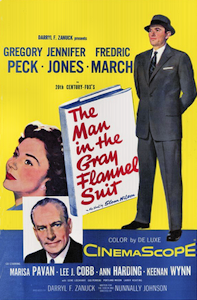Mika Carpenter
Trace Peterson
Integrative Seminar 2
February 20th, 2015
The Legacy of The Gray Flannel Suit
The gray flannel suit in its full glory was the epitome of 1950’s living. As men were coming back from war, they sought out jobs that could allow them to support their families comfortably. This often led them to strict corporate careers that supplied them the monetary means, but not the emotional means needed to hold together a family that lacked a father figure throughout the war. The government did little to nothing to care for the troubled soldiers, or offer freedom to everyone. The gray flannel suit became the symbol for not only masculine ambition and prosperity, but also became a means to romanticize an era riddled with misogyny and racism. The straight, middle class white man donned the gray suit, making them appear more prosperous that everyone else, when in reality they were also drowning in sorrow, as the rest of the country was torn apart. The suit screamed brokenness as much as it did success, and simply covered, both physically and mentally, the immense damage caused by World War II.
As the troops were coming home, families were united and free to live out their dreams. These dreams commonly entailed a nice house with a white picket fence, a beautiful wife, and loving children. Neighborhood developments sprang up everywhere, with cookie-cutter houses and picturesque families to inhabit them. This idealized perfection brought with it a sense of male superiority, however. The gray suit was for men, and for men only. Women’s role in society was made clear by the gray suit, because it was designed and tailored to fit the modern businessman. Advertisements and television shows portrayed perfect families with working fathers, stay at home mothers, and well-behaved children, misrepresenting the entire time period during which the gray flannel suit was popular. Shows like Leave It to Beaver and Father Knows Best helped to disguise a raw time in American history, modeling the perfect American homes. These shows did not address the issues so prominent in American culture; the plight of African Americans and women being oppressed, and actually perpetuated the idea of keeping women at home to care for the house and leaving African Americans completely out of the race for success.
The connection between the iconic suit and World War II were examined in the book, The Man in the Gray Flannel Suit by Sloan Wilson. The suit stood to symbolize the protagonist’s dream of a normal life after coming back from war. The book unflinchingly reveals the darkest corners of a veteran’s life, delving into Tom’s broken psyche as a result of post-traumatic stress, an affair that resulted in an illegitimate child, and the death of his grandmother, which Tom attempts to ignore by delving into a new career. This mindset was common during the time period in which the gray flannel suit was popular; do not address the problem, simply carry on as you did before war, and the resulting issues will go away. The suit represented conformity in every aspect of life- family, career, and personal- and encouraged men to work as much as they could to support their families. Tom learns that the most powerful men he works for are only destroying their families, and themselves, however. All the time spent away from home in order to provide for them only brings misery, as Tom rarely has time to care for his family, and for his own mental health.
Tom couldn’t find happiness in his career, and the money he earned did not take away from the trauma and stress that was eating away at him. He was “brooding about the past and worrying about the future, there had never been any present at all” (Wilson); he was haunted by both his experiences and the experiences he wished to have. The idea of climbing the corporate ladder is new to Americans, and they soaked it up eagerly. Betsy and Tom expected to be healed by Tom’s newfound success but were only left to wonder why they still struggled even though “[Tom’s] job is plenty good enough. We’ve got three nice kids, and lots of people would be glad to have a house like this. We shouldn’t be so discontented all the time” (Wilson). They fixed their house to their liking and tried to raise well-behaved kids but didn’t address the cracks in their minds; the cracks that had the power to bring the family back together, had they been mended.
Upon seeing the gray flannel suit, one envisions a successful, put together man typical of the 1950’s. This is the accepted story, an idealized view of a time in history marked with aprons, Cadillac’s, and strong family values. Magazines like True and Bluebook became templates for everything the American veteran wanted to attain, portraying veterans as confident, and dedicated to their country, while providing manly past times they should like, like fishing. This provided returning soldiers with an escape from reality; a cover to strive for, as asking for help was almost nonexistent. Veterans searched for acceptance, and fell into conformity, the gray flannel suit replacing their war uniforms, but representing the same suffocating ideals. Perhaps this was the initial intent of the suit, or it just spiraled into a façade along the way. This is the accepted story of the 1950’s, often glorified and always remembered for it’s pristine houses. Beneath the suit lies weakness that no man from this time period was encouraged to admit, or accept.
